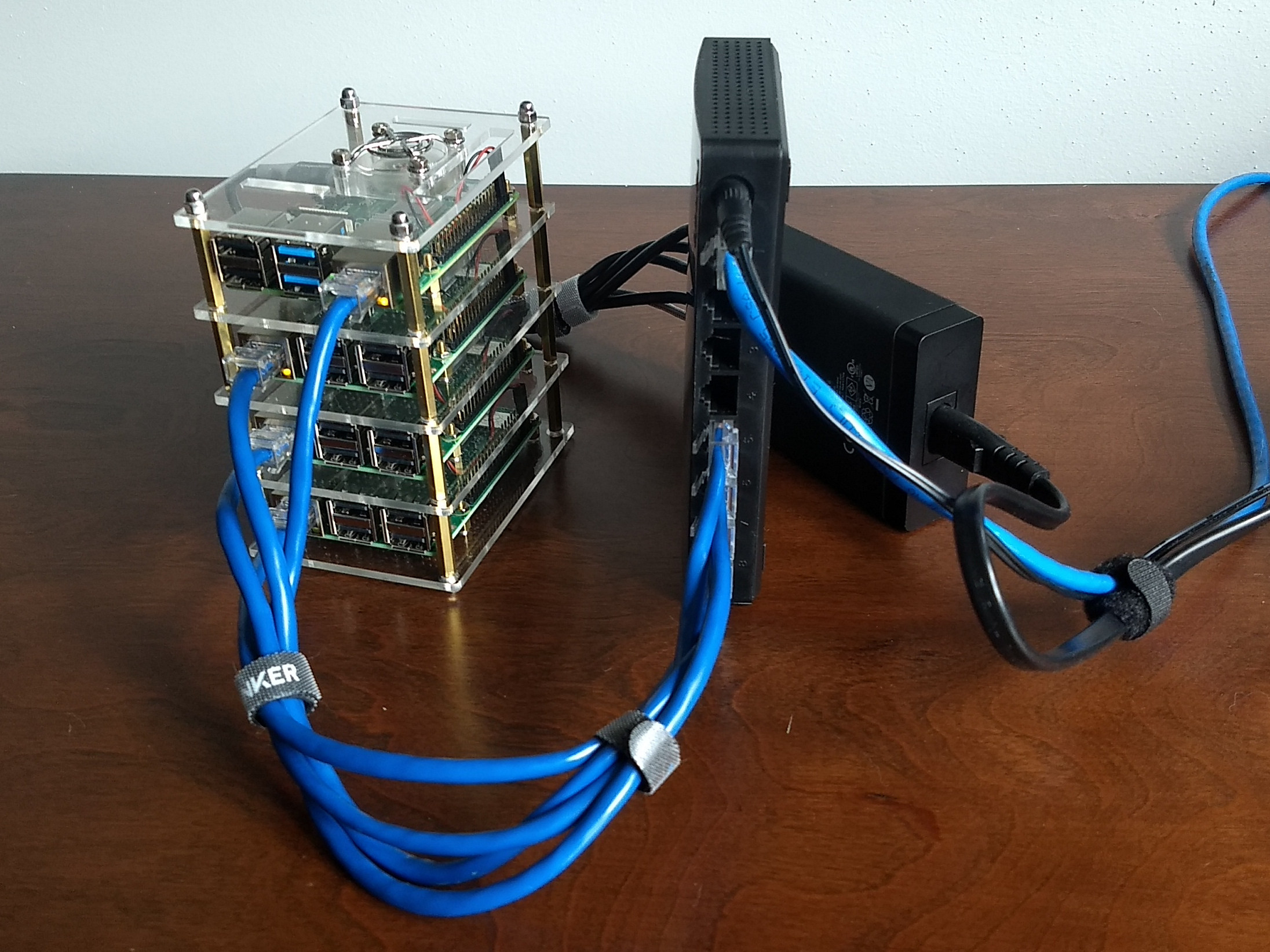Kubernetes on Rasberry Pi
A cluster of Raspberry Pis (a bramble*) running Kubernetes (k8s), provisioned via Ansible.
Questions?
Did I leave anything out, or is anything unclear? Please let me know! Open an issue. There's a lot of bits involved in getting this working, and it's possible -- likely even -- that I forgot to document something.
Prerequisites
SSH access
touch /Volumes/boot/ssh
PW=`cat ~/.network.pw` envsubst < ~/dev/raspberrypi/wpa_supplicant.conf > /Volumes/boot/wpa_supplicant.conf
Hardware
- Three or more Raspberry Pi 3 or 4
- For the master node(s), I strongly recommend a Pi with at least 2GB RAM
- Class 10 SD Cards
- Power, space and cooling
- Network switch and short ethernet cables
- Internet
Software
- Raspbian (installed on each Raspberry Pi)
- Raspberry Pis should have static IPs
- Requirement for Kubernetes and Ansible inventory
- You can set these via OS configuration or DHCP reservations (your choice)
- Ability to SSH into all Raspberry Pis and escalate privileges with sudo
- The pi user is fine just change its password
- Ansible 2.2 or higher
kubectlshould be available on the system you intend to use to interact with the Kubernetes cluster.- If you are going to login to one of the Raspberry Pis to interact with the cluster
kubectlis installed and configured by default on the master Kubernetes master. - If you are administering the cluster from a remote machine (your laptop, desktop, server, bastion host, etc.)
kubectlwill not be installed on the remote machine but it will be configured to interact with the newly built cluster oncekubectlis installed.
- If you are going to login to one of the Raspberry Pis to interact with the cluster
- Setup SSH key pairs so your password is not required every time Ansible runs
iptables
The iptables tooling can act as a compatibility layer, behaving like iptables but actually configuring nftables. This nftables backend is not compatible with the current kubeadm packages: it causes duplicated firewall rules and breaks kube-proxy.
Ensure iptables tooling does not use the nftables backend
ansible-playbook iptables.yml
Usage
Clone the repo
git clone git@github.com:clebio/k8s-bramble.git
Modify the inventory file to suit your environment. Change the names
to your liking and the IPs to the addresses of your Raspberry Pis. If
your SSH user on the Raspberry Pis are not the Raspbian default pi
user modify remote_user in the ansible.cfg.
Confirm Ansible is working with your Raspberry Pis:
ansible -m ping all
Configure the cluster:
ansible-playbook cluster.yml
ansible-playbook cluster.yml --tags provision
Set your kubeconfig (the config file is fetched in cluster.yml though):
ansible bramble4 -m fetch -a 'src=/etc/kubernetes/admin.conf dest=./kube.config'
export KUBECONFIG=kube.config/bramble4/etc/kubernetes/admin.conf
kubectl cluster-info
Test your Kubernetes cluster is up and running:
kubectl get nodes
To power the whole thing down,
ansible all -m command -a shutdown
Kubernetes manifests
Once you have a working cluster, deploy system manifests into the cluster:
kubectl apply -f system-manifests/metallb.yaml
kubectl apply -f system-manifests/metallb-config.yaml
kubectl apply -f system-manifests/nfs-client-provisioner.yaml
kubectl apply -f system-manifests/cert-manager.yaml
kubectl apply -f system-manifests/letsencrypt-issuers.yaml
kubectl apply -f system-manifests/nginx-ingress-cloud.yamlOverall, there are a few resources I recommend installing:
Ingress
MetalLB provides a standard LoadBalancer service:
kubectl apply -f manifests/metallb.yaml
kubectl apply -f manifests/metallb-config.yaml
In that MetalLB config, we defined a certified pool of size /32 so that we can map that in our home router's NAT (external to this Bramble setup). If we then annotate the Nginx ingress configuration's LoadBalancer accordingly, we can create a predictable entrypoint to our private, NAT'd cluster.
apiVersion: v1
kind: Service
metadata:
annotations:
metallb.universe.tf/address-pool: certified
spec:
type: LoadBalancer
# ...kubectl apply -f manifests/nginx-ingress-cloud.yaml
NFS for PVCs
I use the NFS client example to provide persistent volume claims (PVC) via my Synology NAS:
kubectl apply -f manifests/nfs-client-provisioner.yaml
Dashboard
kubectl apply -f example-manifests/kubernetes-dashboard-arm.yaml
kubectl describe secret kubernetes-dashboard-token-8qksk -n kubernetes-dashboard
Diagnostics
Raspberry Pi aren't terribly large machines. You might run out of resources. One quick and dirty check:
ansible -i inventory all -m shell -a 'cat /proc/meminfo | grep -i memfree'
References & Credits
These playbooks were assembled using a handful of very helpful guides:
- Thanks to Jeff Geerling for the "bramble" reference.
- This repo is derived from rak8s.
- K8s on (vanilla) Raspbian Lite by Alex Ellis
- Installing kubeadm
- kubernetes/dashboard - Access control - Admin privileges
- Install using the convenience script
- A very special thanks to Alex Ellis and the OpenFaaS community for their assitance in answering questions and making sense of some errors.
